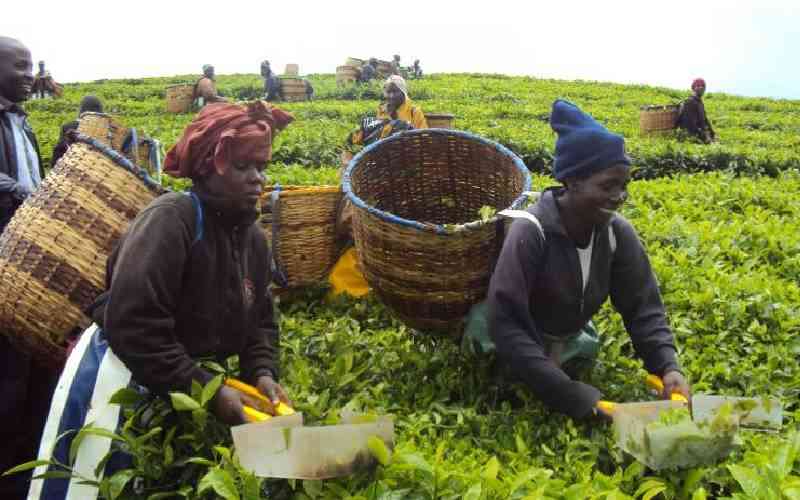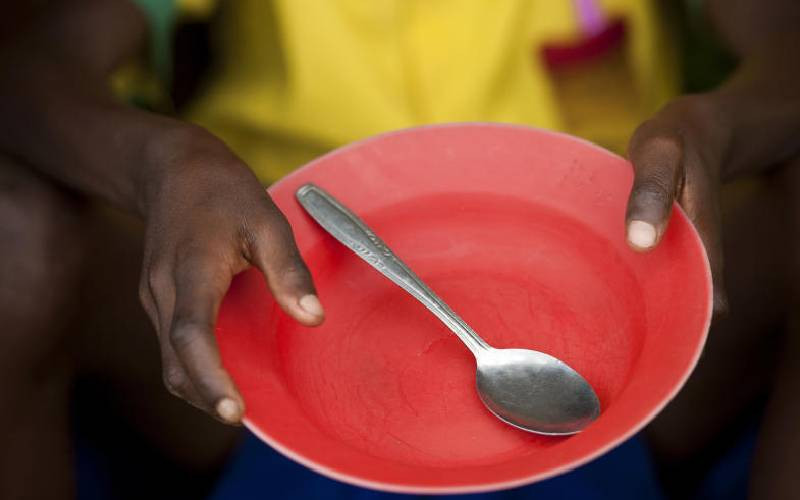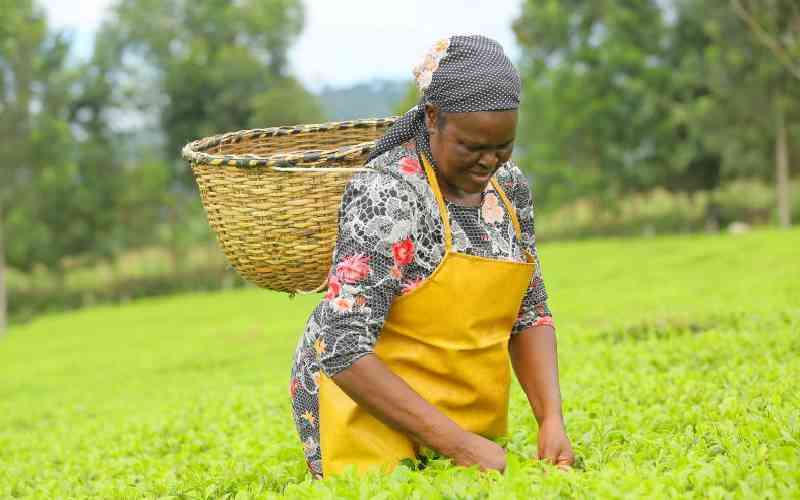Tea pluckers at Finlays in Kericho County. [File, Standard]

In the coming days, tea farmers across Kenya will receive the much anticipated news of this year’s final `payment (popularly known as bonus). For many, this announcement is more than a financial update. It is a verdict on a year of sweat, sacrifice, and hope. Yet, early indications point to lower earnings compared to last year.
Understandably, this is bound to stir discontent. But before the anger finds a target, we must step back and ask: what really determines tea prices, and how can we, collectively, build a more resilient sector?
For decades, tea has been the green lifeline of millions of Kenyan households, especially in the Central, West of Rift and East of the Rift regions. Kenya is the world’s leading exporter of black tea, and the second largest producer after China. But unlike China and India, where farmers and governments have diversified tea into premium and specialty products, Kenya has remained heavily reliant on bulk black tea exports, sold in an auction, at Mombasa. This, in my opinion, is a system that is vulnerable to global market swings, and prone to exploitation by middle men.
That notwithstanding, several factors, both local and global, shape the price of tea.
Global demand and supply. When global tea production surges, as seen recently in India and Sri Lanka, oversupply depresses prices across international auctions. Conversely, poor harvests in competitor countries can push prices up.
Economic conditions and geo politics in consuming countries. For example, the recent economic strain and foreign exchange crisis in Pakistan, which is a key market for Kenyan tea, significantly weakened its ability to import our tea. The civil unrest in other key markets such as Sudan, Ukraine and Russia negatively affects the tea market.
Exchange rate fluctuations. Tea is traded in dollars. Therefore, the strength or weakness of the Kenya shilling against the dollar directly affects farmers’ payouts. Even if auction prices hold steady, a weaker shilling will mean that each dollar earned from tea exports converts into more Kenyan shillings, boosting the income received by farmers. While on the other hand, a weaker shilling translates to higher prices of imported agricultural inputs such as fertilizer.
Production and input costs. Luckily the farmers were cushioned from rising costs of fertilizer through subsidy from the government where they paid Sh2500 per 50kgs instead of Sh3400.
Climate change. Changes in the climatic conditions continues to threaten the viability of the tea sector. In Kenya, tea farming relies almost 100% on rainfall. In recent times, the patters have changed drastically, with longer dry seasons been witnessed over the years. Even more worrisome, experts (Ethical Tea Partnership, 2021; Jayasinghe & Kumar, 2020; Kramer & Ware, 2021) are predicting that yields will decrease by 5% in China, 14% in Sri Lanka, and 25% in Kenya by 2050 due to climate change.
Value addition and product type. Kenya exports nearly 95% of its tea in bulk form. Yet specialty teas such as green, purple, orthodox teas, command premium prices on global shelves. The reality is simple: until Kenya significantly shifts towards value addition, it will remain at the mercy of commodity pricing.
Global lessons and case scenarios
Kenya is not alone in grappling with the volatility of tea pricing. There are lessons we can draw from other tea-producing nations:
Stay informed. Subscribe to our newsletter
Sri Lanka: Despite political upheavals, Sri Lanka has managed to carve a niche by positioning its own branded tea - “Ceylon Tea” as a premium global brand. Strict quality controls and heavy investment in branding have ensured their tea attracts higher prices per kilo than Kenya’s.
China: The world’s largest producer has mastered diversification. Beyond black and green tea, China has popularized white, oolong, and specialty teas, fetching very good prices in niche markets. This strategy shields their farmers from the lows of bulk pricing.
India: With strong domestic consumption, India’s tea sector is less exposed to the vagaries of international markets. By cultivating a robust local tea culture, they guarantee farmers a steady demand base.
For Kenya, the lesson is clear. While we cannot control global forces, we can reposition ourselves. Developing a strong “Brand Kenya Tea” identity, expanding into specialty markets, and promoting local consumption could cushion farmers against global volatility.
The role of KTDA
No discussion about tea in Kenya is complete without the mention of the Kenya Tea Development Agency (KTDA) which is owned by farmers and manages over 55% of tea production in Kenya. The factories cut across different geographical location in Kenya and operational costs and prices for the teas are varied in the market place. This leads to differences in pay for farmers in different factories.
The new KTDA leadership under Chairman Chege Kirundi who has been in the sector for more than 20year has embraced a new Mantra Farmers First. None to be left behind. This is commendable. Farmers are looking for action. They want timely supply of inputs, leaner operational costs, transparency in auction processes, and innovative approaches to marketing. Leadership is key and the new direction from the chairman is a pointer in the right direction
Everyone has a role to play
It is easy to point fingers, but building a stronger tea sector requires a shared responsibility:
Farmers need provide t embrace better agronomic practices and improve in quality, adopt new technologies and efficiency to cut operational costs with factories cutting inefficiencies.
Government must play an enabling role by investing in infrastructure, negotiating better trade deals, and supporting value addition initiatives.
Consumers. Increase local consumption. Kenyan only consume 5% of the tea produced unlike India and China.
The hard truth and a bright future ahead
Yes, the bonus this year will likely be lower. But the question we should ask is not just why bonuses are down, but what we can do differently. Are we willing to invest in branding and value addition? Are our institutions ready to walk the talk on reforms?
Kenya’s tea sector is at a crossroads. We can either continue with business as usual, locked in cycles of global shocks and vulnerability, or we can choose a path of reinvention. The best-case scenario is not out of reach: a sector that pays farmers fairly, competes globally with premium brands, will sustains Kenya’s place as a global tea giant.
Population is growing globally and so is the market expected to grow.
The writer is the Head of innovation, intellectual property and community engagement, Mount Kenya University







